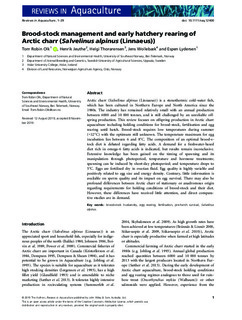| dc.contributor.author | Olk, Tom Robin | |
| dc.contributor.author | Thorarensen, Helgi Thor | |
| dc.contributor.author | Jeuthe, Henrik | |
| dc.contributor.author | Wollebæk, Jens | |
| dc.contributor.author | Lydersen, Espen | |
| dc.date.accessioned | 2020-01-15T12:28:52Z | |
| dc.date.available | 2020-01-15T12:28:52Z | |
| dc.date.created | 2019-12-16T09:18:44Z | |
| dc.date.issued | 2019 | |
| dc.identifier.citation | Reviews in Aquaculture. 2019. | nb_NO |
| dc.identifier.issn | 1753-5123 | |
| dc.identifier.uri | http://hdl.handle.net/11250/2636420 | |
| dc.description | This is an open access article under the terms of the Creative Commons Attribution License, which permits use, distribution and reproduction in any medium, provided the original work is properly cited. | nb_NO |
| dc.description.abstract | Arctic charr (Salvelinus alpinus (Linnaeus)) is a stenothermic cold‐water fish, which has been cultured in Northern Europe and North America since the 1980s. The industry has remained relatively small with an annual production between 6000 and 10 000 tonnes, and is still challenged by an unreliable offspring production. This review focuses on offspring production in Arctic charr aquaculture including holding conditions for brood‐stock, fertilisation and egg rearing until hatch. Brood‐stock requires low temperatures during summer (<12°C) with the optimum still unknown. The temperature maximum for egg incubation lies between 6 and 8°C. The composition of an optimal brood‐stock diet is debated regarding fatty acids. A demand for a freshwater‐based diet rich in omega‐6 fatty acids is indicated, but results remain inconclusive. Extensive knowledge has been gained on the timing of spawning and its manipulation through photoperiod, temperature and hormone treatments; spawning can be induced by short‐day photoperiod; and temperature drops to 5°C. Eggs are fertilised dry in ovarian fluid. Egg quality is highly variable and positively related to egg size and energy density. Contrary, little information is available on sperm quality and its impact on egg survival. There may also be profound differences between Arctic charr of stationary or anadromous origin regarding requirements for holding conditions of brood‐stock and their diet. However, these differences have received little attention, and direct comparative studies are in demand. | nb_NO |
| dc.language.iso | eng | nb_NO |
| dc.rights | Navngivelse 4.0 Internasjonal | * |
| dc.rights.uri | http://creativecommons.org/licenses/by/4.0/deed.no | * |
| dc.title | Brood‐stock management and early hatchery rearing of Arctic charr (Salvelinus alpinus (Linnaeus)) | nb_NO |
| dc.type | Journal article | nb_NO |
| dc.type | Peer reviewed | nb_NO |
| dc.description.version | publishedVersion | nb_NO |
| dc.rights.holder | © 2019 The Authors | nb_NO |
| dc.source.pagenumber | 29 | nb_NO |
| dc.source.journal | Reviews in Aquaculture | nb_NO |
| dc.identifier.doi | 10.1111/raq.12400 | |
| dc.identifier.cristin | 1760983 | |
| cristin.unitcode | 222,58,1,0 | |
| cristin.unitname | Institutt for natur, helse og miljø | |
| cristin.ispublished | true | |
| cristin.qualitycode | 1 | |

